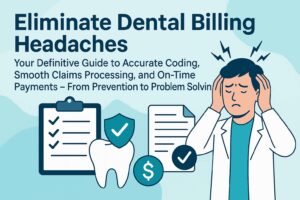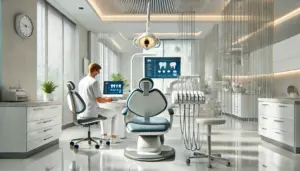
Exploring ADA Code: Top Most Popular CDT Codes of 2024

Staying updated with the latest ADA codes is essential for ensuring compliance and enhancing the efficiency of dental practices. The ADA CDT 2024 Book and App serve as an indispensable resource, providing the most current and comprehensive information needed for accurate documentation of dental services. This guide includes every code along with its full descriptor, which is crucial for determining whether the code accurately reflects the service provided, thereby supporting ADA compliance and adherence to standards. With a focus on the 50 most popular CDT codes of 2024, this article intends to navigate through the realms of diagnostic services, preventative care, restorative services, and more, highlighting the significance of these codes in maintaining high standards of care and compliance with ADA guidelines.
Accurate procedure coding not only meets HIPAA requirements for electronic health records but also plays a vital role in potential coverage assessments under policies. It’s a practice that demands integrity; misrepresentation for greater payment or reimbursement is not only unethical but could also lead to disciplinary actions. As the dental field continues to advance, the need for understanding ADA codes—rooted not in the products or technology but in risk and diagnosis—becomes even more critical. This article aims to equip dental professionals with the knowledge of the most utilized ADA codes of 2024, ensuring they stay at the forefront of compliance and excellence in dental care.
Understanding CDT Codes
CDT codes, formally known as Current Dental Terminology, are essential tools for the standardization and documentation of dental procedures. These codes are meticulously maintained and updated annually by the ADA Council on Dental Benefit Programs, ensuring they meet the evolving needs of the dental community and comply with HIPAA requirements for electronic health records. Each CDT code consists of a unique 5-digit alphanumeric code, accompanied by nomenclature and a descriptor that clearly defines the scope of the procedure, making it easier for dental professionals and insurance companies to communicate effectively.
For 2024, the American Dental Association has introduced significant updates to the CDT codes, including 15 new codes and the addition of a new category specifically for sleep apnea services. These updates are crucial for dental professionals to adhere to, especially when submitting claims to insurance providers like Delta Dental for services performed from January 1, 2024, onwards. The CDT 2024 Kit, which includes resources like the CDT 2024: Current Dental Terminology book and the CDT 2024 App, provides comprehensive access to these codes, ensuring practitioners can search and apply the most current codes across up to 10 devices.
Furthermore, the CDT 2024 Book and App are designed to enhance understanding and ease of use. They are organized by specialty-specific codes and include detailed illustrations that help clarify the anatomy involved in each procedure. Additionally, they offer cross-coding with ICD-10-CM diagnosis codes and include quarterly updates on CCI edits for CDT, CPT, and HCPCS procedure codes, making them an indispensable tool for any dental practice striving for accuracy in coding and billing. For personalized support, ADA members can access free coding assistance, which is particularly beneficial for practices like One Dental Billing, ensuring they maintain compliance and efficiency in their billing processes.
Top 10 CDT Codes for Diagnostic Services
Dental professionals rely heavily on accurate diagnostic codes to ensure compliance and streamline patient care. Among the most utilized CDT codes for diagnostic services in 2024 are:
D0120: Periodic Oral Evaluation – Established Patient
Regular evaluations are crucial for maintaining dental health, making D0120 a frequently used code.D0140: Limited Oral Evaluation – Problem Focused
This code is applied when addressing specific dental issues, providing a focused approach to patient care.D0150: Comprehensive Oral Evaluation – New or Established Patient
Comprehensive evaluations encompass a thorough assessment of the dental and oral health of both new and returning patients.D0160: Detailed and Extensive Oral Evaluation – Problem Focused, by Report
Used for complex cases requiring detailed examination and reporting, D0160 is essential for specialized diagnostic needs.D0170 and D0171: Re-evaluation Codes
Post-treatment evaluations and follow-ups are critical, covered under codes D0170 for general re-evaluation and D0171 for post-operative visits.D0180: Comprehensive Periodontal Evaluation – New or Established Patient
This code ensures thorough periodontal health assessments, crucial for patients with or at risk of periodontal diseases.D0190 and D0191: Screening and Assessment
Initial screenings (D0190) and assessments (D0191) play pivotal roles in early detection and preventive care strategies.D0210: Intraoral – Complete Series of Radiographic Images
A complete radiographic series provides a full overview of the dental structures and is vital for comprehensive diagnostic processes.D0330: Panoramic Radiographic Image
Panoramic images are indispensable for viewing a broad dental region, aiding in diagnosis and treatment planning.D0367: Cone Beam CT Capture and Interpretation with Field of View of Both Jaws
Advanced imaging technology like Cone Beam CT is increasingly crucial for detailed dental evaluations and is represented by D0367.
For dental practices like One Dental Billing, understanding and applying these CDT codes accurately ensures efficient billing and compliance with ADA standards. The integration of such codes into daily practice not only supports dental health management but also aligns with the regulatory requirements, enhancing overall practice efficiency.
Most Used CDT Codes for Preventative Care
In the realm of preventative dental care, certain CDT codes stand out for their frequent application and crucial role in maintaining oral health. These codes not only facilitate routine care but also ensure that dental practices like One Dental Billing can provide effective, compliant services.
CDT Code D1354: Application of Caries-Arresting Medication, Per Tooth
Initially approved in 2016, this code is primarily used for the application of substances like silver diamine fluoride (SDF), which actively arrest carious lesions. This treatment is pivotal in halting the progression of cavities and is a cornerstone of modern preventative dental care.CDT Code D2991: Application of Hydroxyapatite Regeneration Medicament, Per Tooth
Set to be introduced in CDT 2024, this code covers the application of hydroxyapatite, a substance crucial for the regeneration of enamel on incipient lesions. Unlike other treatments that merely arrest decay, this procedure actively promotes the restoration of tooth structure, representing a significant advancement in preventative care.CDT Code D1110: Prophylaxis (Adult)
This code describes a standard adult prophylaxis, which includes the thorough cleaning and polishing of teeth. Regular use of this code in preventative care helps in maintaining oral hygiene and preventing periodontal disease, which are essential for long-term dental health.
By incorporating these CDT codes into their service offerings, dental practices ensure adherence to ADA standards and enhance their operational efficiency. For companies like One Dental Billing, understanding and applying these codes accurately is crucial for streamlined billing and compliance, ultimately supporting the health management and regulatory alignment of dental practices.
Key CDT Codes for Restorative Services
The 2024 updates to the CDT codes introduce several new and revised codes crucial for restorative dental services, ensuring practices like One Dental Billing can maintain precision in billing and compliance with ADA standards. Notably, the inclusion of codes such as D0396, which involves the 3D printing of a dental surface scan, reflects the growing integration of advanced technology in dental restorations. Additionally, D2976 addresses the stabilization of a tooth with a band per tooth, a procedure essential for treatments requiring temporary structural support.
Further innovations in restorative procedures are evident with D2989, which deals with the excavation of a tooth to determine its non-restorability. This code is critical for assessing whether a tooth can be saved or needs extraction, a decision pivotal in treatment planning. Meanwhile, D2991 introduces a groundbreaking approach to dental care with the application of hydroxyapatite, a regenerative medicament that aids in enamel restoration, marking a significant advancement in restorative dental care.
Moreover, the maintenance and management of dental implants have received attention with the introduction of D6089, which focuses on accessing and retorquing a loose implant screw. This code is vital for the longevity and functionality of dental implants, ensuring they remain secure and effective. Additionally, D7284, which involves the excisional biopsy of minor salivary glands, highlights the critical intersection of diagnostic and restorative services, facilitating precise interventions in cases of glandular anomalies.
Revised nomenclature for existing codes also plays a significant role in enhancing clarity and specificity in dental billing. For instance, D2335 now more accurately describes the application of a resin-based composite on four or more surfaces of an anterior tooth, ensuring detailed billing. Similarly, D5876 has been updated to reflect the addition of a metal substructure to an acrylic full denture per arch, a modification that enhances the durability and function of full dentures.
By adopting these new and revised CDT codes, practices like One Dental Billing not only ensure compliance with the latest ADA standards but also enhance the precision and efficacy of restorative dental treatments, ultimately benefiting patient care and practice efficiency.
CDT Codes for Periodontics
In the specialized field of periodontics, the ADA has introduced several new and revised CDT codes for 2024, which are critical for dental professionals to ensure accurate billing and compliance with updated standards. Noteworthy among these are new codes such as D0396, D2976, D2989, D6089, D7284, D9938, D9939, D9954, D9955, D9956, and D9957, each tailored to meet specific needs within periodontal treatments. These codes cover a range of procedures from 3D printing of dental scans to the application of regenerative materials, reflecting the ongoing advancements in dental technology and treatment methods.
Revised codes such as D2335, which now more accurately describes the application of a resin-based composite on four or more surfaces of an anterior tooth, and D5876, which details the addition of a metal substructure to an acrylic full denture per arch, also play a significant role. These revisions enhance the clarity and precision of billing practices, aiding practices like One Dental Billing in maintaining high standards of service and compliance.
Furthermore, policy revisions have been made concerning radiographic imaging, which include intraoral and panoramic images, as well as cone beam CT capture and interpretation. These changes ensure that image interpretation by practitioners not associated with the capture of the image adheres to new standards, supporting accurate diagnostics and treatment planning in periodontics. For dental practices, staying updated with these codes is not just about compliance but also about enhancing the efficiency and effectiveness of patient care.
Orthodontic CDT Codes Overview
In 2024, the ADA has introduced several new CDT codes specifically tailored for orthodontic services, reflecting advancements in dental technology and treatment methods. Among these, D2976 is notable for its application in orthodontic band stabilization per tooth, typically used after a tooth has lost structure, which is crucial for maintaining the integrity of the dental arch during treatment. This procedure involves the cementing of a band around the tooth, providing necessary support and stability.
Another significant addition is D9938 and D9939, which address the fabrication and placement of a custom removable clear plastic temporary aesthetic appliance, respectively. These codes are particularly relevant for practices like One Dental Billing, as they cater to the growing demand for aesthetic solutions in orthodontics, allowing for temporary cosmetic enhancements while permanent solutions are being prepared.
Furthermore, the introduction of D9954 and D9955, which cover the fabrication and delivery of oral appliance therapy (OAT) morning repositioning devices and OAT titration visits, respectively, highlight the ADA’s focus on comprehensive care in orthodontics. These codes ensure that patients receive the necessary adjustments and follow-up care essential for the effectiveness of orthodontic treatments, enhancing the overall treatment outcomes and patient satisfaction.
CDT Codes for Oral Surgery
In the evolving landscape of dental surgery, the introduction of new CDT codes ensures that dental practices like One Dental Billing can remain at the forefront of compliance and efficiency. Among these, the code D2989 is particularly crucial as it involves the excavation of hard or soft tissues, or both, as indicated, for determining non-restorability. This procedure is essential for assessing the viability of a tooth before deciding the appropriate surgical intervention.
Another significant code, D7939, is used for indexing for osteotomy using dynamic robotic-assisted or dynamic navigation technologies. This advanced technique enhances the precision and safety of surgical procedures, allowing for more accurate implant placements and other complex surgeries. Additionally, D0396 facilitates the post-processing of 3D image sets, which is integral in planning and executing complex oral surgeries with higher accuracy and better patient outcomes.
Furthermore, certain codes are designated with specific coverage limitations to ensure optimal use and cost management. For instance, D2976 is a covered benefit limited to once per tooth per lifetime and is applicable only to posterior permanent teeth. Similarly, D6089, which deals with the maintenance of dental implants, is covered once every 24 months, reflecting the periodic need for professional intervention to ensure the longevity of implant treatments. It’s important for practices to understand these limitations as they directly impact billing and insurance claims, areas where One Dental Billing provides expert support to ensure smooth operational flow and compliance.
Emerging Trends in CDT Coding
The ADA’s commitment to enhancing dental practice efficiency and compliance is evident in the latest updates to the CDT codes for 2024. This year introduces a total of 16 changes, including 14 new codes and 2 revisions, aimed at addressing the evolving needs of dental healthcare. Notably, a significant addition is the establishment of a new category for sleep apnea services, reflecting the growing recognition of dental professionals’ role in diagnosing and managing sleep-related conditions.
Among the notable new entries, D9956 and D9957 focus on the administration of home sleep apnea tests and screening for sleep-related breathing disorders, respectively. These additions underscore the expanding scope of dental practices into areas traditionally handled by medical practitioners and highlight the ADA’s efforts to integrate more comprehensive health services within dentistry.
Furthermore, the CDT 2024 updates include practical codes like D6089, which deals with accessing and retorquing loose implant screws, a procedure essential for maintaining the longevity and effectiveness of dental implants. This update, along with others like D2989, which facilitates the excavation of teeth to determine non-restorability, are critical for enhancing diagnostic accuracy and treatment efficacy in dental practices.
For dental practices such as One Dental Billing, these updates are crucial. They not only ensure compliance with the latest ADA standards but also enhance the precision and efficacy of dental billing and treatment, ultimately benefiting patient care and practice efficiency.
Staying Informed on CDT Code Changes
The American Dental Association (ADA) ensures that dental professionals stay updated with the most accurate and current information through the annual release of the CDT book and app. The CDT 2024 edition is particularly comprehensive, containing every code alongside its full descriptor, which is crucial for verifying the appropriateness of procedure codes during claim submissions. This meticulous documentation aids in resolving any discrepancies or questions regarding the accuracy of claims, thereby facilitating smoother reimbursement processes for practices like One Dental Billing.
In addition to the resources provided directly by the ADA, dental practices benefit from supplementary guides and systems designed to streamline the integration of new CDT codes into daily operations. For instance, the CDT 2024 Companion serves as an essential training tool for dental teams, emphasizing the importance of submitting accurate claims to avoid costly mistakes. Moreover, Dentrix, a leading practice management system, updates its software to include the latest CDT codes, ensuring that users with an active service plan receive these updates automatically. This seamless integration supports dental practices in maintaining compliance without disrupting their workflow.
The ADA also offers a rich array of educational materials and services, ranging from clinical dentistry to practice management. These resources are designed to enhance the professional capabilities of dental teams and include access to a comprehensive reference library with coding educational materials. For dental professionals looking to stay ahead in their field, engaging with these ADA resources, reviewing policy changes, and adopting the latest CDT codes are indispensable practices that align with the standards of excellence and compliance required in modern dental care.
Conclusion
Through meticulous exploration, this article shed light on the pivotal role of updating and comprehending ADA’s CDT codes for the year 2024, underscoring how critical they are for dental practices like One Dental Billing in maintaining compliance, enhancing billing accuracy, and elevating patient care standards. Each section, from diagnostic services and preventative care to restorative services and oral surgery, emphasizes the continuous advancements within dental healthcare and the imperative need for practices to adapt to these changes. Moreover, the insights into emerging trends and the detailed overview of orthodontic and periodontic coding updates demonstrate the ever-evolving intersection of dentistry with cutting-edge technology and patient-centric approaches.
As we conclude, it becomes evident that staying abreast of the latest ADA code changes is not just a regulatory necessity but a cornerstone in the pursuit of excellence in dental care delivery. Practices committed to this endeavor not only ensure streamlined operations but also contribute significantly to the broader goals of patient satisfaction and clinical outcomes. For those looking to navigate these complexities with expertise and efficiency, explore the best remote dental billing services in the USA, which stand ready to support dental practices in achieving these goals. In embracing these updates and seeking out specialized support, dental professionals can continue to refine their craft and uphold the highest standards of care in the coming year and beyond.
FAQs
1. What updates have been made to the CDT codes for the year 2024?
In 2024, the CDT codes have been updated to include 14 new codes and the introduction of a new category for sleep apnea services. Additionally, there are two revised codes and several policy updates. It’s important to note that the availability of coverage for these new codes will depend on the specific benefits outlined in a patient’s insurance plan.
2. What new CDT codes are featured in the 2024 Dental Terminology Book?
The 2024 edition of the Dental Terminology Book introduces several new CDT codes, including those for screening for sleep-related breathing disorders, fabrication and delivery of oral appliance therapy (OAT), and excisional biopsy of minor salivary glands.
3. How do ADA codes differ from CDT codes?
CDT codes, or Current Dental Terminology codes, are a standardized set of codes used by dental professionals in the United States. These codes, which are maintained by the American Dental Association (ADA), are utilized for billing, insurance claims, and maintaining patient records. They help in accurately describing dental procedures.
4. How many CDT codes are currently in use?
As of the latest update in 2023, there are 800 CDT procedure codes available for use by dental professionals. These codes must be used accurately to ensure proper documentation and billing for dental services.
Contact Us
Phone: 908-357-1515
111 Town Square Pl, Suite 1203 Jersey City, NJ 07310












